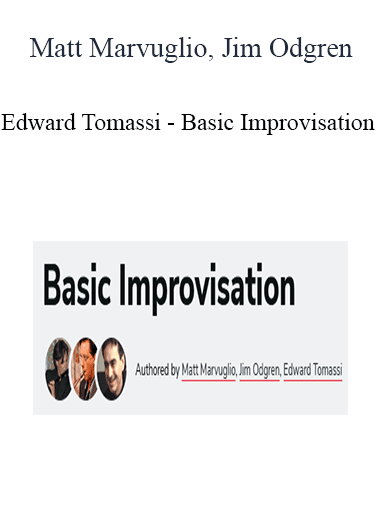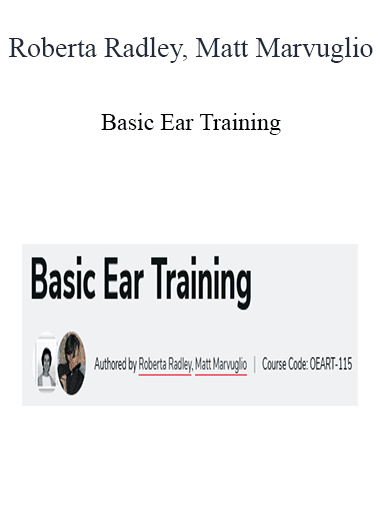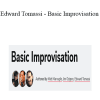Matt Marvuglio, Jim Odgren, Edward Tomassi – Basic Improvisation
$1,250.00 Original price was: $1,250.00.$250.00Current price is: $250.00.
Digital Download: You will receive a download link via your order email after successful payment.
Learn the solo riffs and licks of the masters: Jimmy Page, BB King, Charlie Parker and others, and how to develop your own! “What notes do I play?
Basic Improvisation
Learn the solo riffs and licks of the masters: Jimmy Page, BB King, Charlie Parker and others, and how to develop your own! “What notes do I play?” is the first question that comes to mind when a musician is asked to improvise. The answer is easy: notes that are within the key! Basic Improvisation is designed to get you to develop your solos, and organize your thoughts and playing with the sounds around you through a step-by-step approach that applies to all styles and any instrument. You’ll begin by looking at the 12-bar blues form and the pentatonic scale, and gain a greater feel for phrasing your riffs and playing ‘in the pocket’ by studying rhythmic, melodic, and harmonic repetition. You’ll transcribe, record, and submit for instructor review excerpts of solos from legendary players from many different genres (B.B. King, Stevie Wonder, James Brown, Charlie Parker, Lester Young, Jimmy Page, Louis Armstrong and others). You will develop an understanding of the five elements of music: melody, rhythm, harmony, form, and color. You will be able to incorporate these elements into your own playing and also relate them to other improvisers regardless of your primary instrument.
By the end of the course, you will:
- Learn a step-by-step approach to improvisation that applies to all styles and any instrument
- Improve your character and tone and become more confident in your soloing ability by adding cohesiveness and variety to your playing
- Learn to transcribe other instruments and learn the techniques and nuances of the masters on your own instrument
- Become a more natural and spontaneous stage musician
- Apply harmony to your improvisation by adding chord tones and chord scales
- Introduce basic chromaticism to your playing
Syllabus
Lesson 1 What Notes Do I Play?
Lesson 2 Improvising from the Melody
Lesson 3 Hooking Up with the Band Rhythmically
Lesson 4 Minor Blues
Lesson 5 Melodic Motif
Lesson 6 Putting It All Together, Part 1
Lesson 7 Chord Tones
Lesson 8 Basic Chord Scale Soloing
Lesson 9 Basic Chromatic Approach Shapes
Lesson 10 Chromatic Approach Shapes and Their Resolution to Chord Tone Motifs
Lesson 11 Chromatic Approach Shapes to Chord Scale Motifs
Lesson 12 Putting It All Together, Part 2
Requirements
Prerequisites and Course-Specific Requirements
You should have at least one year of study with your instrument, be able to read treble or bass clef, and have a knowledge of the C major scale.
Required Textbook(s)
- None required
Software Requirements
- A basic audio recording tool that will allow you to record yourself and save the recording in MP3 format. You will have a tool to use for this purpose inside the learning environment. Alternatively, you can use software like Audacity or GarageBand.
Hardware Requirements
- Audio interface with an XLR microphone or direct input (depending on instrument) recommended. A built-in microphone is acceptable.
General Course Requirements
Below are the minimum requirements to access the course environment and participate in live chats. Please make sure to also check the Prerequisites and Course-Specific Requirements section above, and ensure your computer meets or exceeds the minimum system requirements for all software needed for your course.
Mac Users
- OS X 10.10 Yosemite or higher
PC Users
- Windows 7 or higher
All Users
- Latest version of Google Chrome
- Zoom meeting software (available in the course when joining your first chat)
- Webcam
- Speakers or headphones
- External or internal Microphone
- Broadband Internet connection
Instructors
Author
Matt Marvuglio (1945-2017) was Dean of the Performance Division at Berklee College. As a virtuosic flutist and composer, he traveled throughout the United States, Europe, and Japan, premiering his compositions for jazz flute. He presented clinics for the National Flute Association, the Acoustic Society of America, and the International Flute Convention in Sao Paulo, Brazil. His composition “Simples of the Moon” for processed flute, EWI MIDI wind controller, and acoustic and electronic percussion, may be heard on the CD Divinations, by Dean Anderson. Matt’s first solo album entitled Why Cry? features three of his own compositions and a number of interpretations of old favorites. His articles on jazz flute playing have appeared in The Instrumentalist. He was the curriculum editor and composer for the Berklee Practice Method series, and wrote and hosted Berklee’s When Music Works DVD Series.
Author
Jim Odgren is Academic Assistant to the Dean of the Performance Division at Berklee College of Music. Odgren is an alto saxophonist who doubles on tenor and soprano saxophones and flute. Throughout his fifteen-year career at Berklee, he has taught in the Performance Studies and Woodwind Departments. From 1980 to 1983, he toured throughout the world and recorded two LPs (Easy As Pie and Picture This) with the Gary Burton Quartet. Since then, he has recorded and/or played with Kevin Eubanks, John Scofield, Kenwood Denard, Jim Kelly, Victor Mendoza, Oscar Stagnaro, George Garzone, and many others. In 1989, he received the Dean of Faculty Award for his work in improvisation at Berklee. In 2002, Odgren released his own CD, Her Eyes. He is author of the instructional DVD, Accelerate Your Saxophone Playing, and coauthor of two books, Berklee Practice Methods: Getting Your Band Together, with Berklee Woodwind Department Chair, Bill Pierce. Odgren graduated from Berklee College of Music in 1976.
Author
Edward Tomassi is an active performer and bandleader, playing saxophones, clarinet, and flute. He has performed with the Rhode Island Philharmonic, Carl Fontana, Hal Galper, Nick Brignola, Bob Mover, the Four Tops, and the Temptations. A professor at Berklee College of Music, since 1976, Edward has taught jazz improvisation, performance, harmony, and history. He also teaches at Brown University, and presents clinics for the Dave Liebman IASJ (International Association of Schools of Jazz), among others. He graduated from Berklee Summa Cum Laude, with a major in composition. His mentors include Dave Liebman, Charlie Mariano, George Coleman, Joe Viola, Charlie Banacos, and Jerry Bergonzi. Edward’s instructional video/DVD is called Jazz Improvisation: Starting Out with Motivic Development (Berklee Press, 2003).
What’s Next?
When taken for credit, Basic Improvisation can be applied towards these associated programs:
Associated Certificate Programs
- General Music Studies Professional Certificate
- General Music Studies Advanced Professional Certificate
- Bass Professional Certificate
- Keyboard Skills Professional Certificate
- Guitar Advanced Professional Certificate
Associated Degree Major
- Bachelor’s Degree in Guitar
Get Download Matt Marvuglio, Jim Odgren, Edward Tomassi – Basic Improvisation at IMC.sale today!
Delivery Method
– After your purchase, you’ll see a View your orders link which goes to the Downloads page. Here, you can download all the files associated with your order.
– Downloads are available once your payment is confirmed, we’ll also send you a download notification email separate from any transaction notification emails you receive from IMC.sale.
– Since it is a digital copy, our suggestion is to download and save it to your hard drive. In case the link is broken for any reason, please contact us and we will resend the new download link.
– If you cannot find the download link, please don’t worry about that. We will update and notify you as soon as possible at 8:00 AM – 8:00 PM (UTC+8).
Thank You For Shopping With Us!






6 reviews for Matt Marvuglio, Jim Odgren, Edward Tomassi – Basic Improvisation
There are no reviews yet.